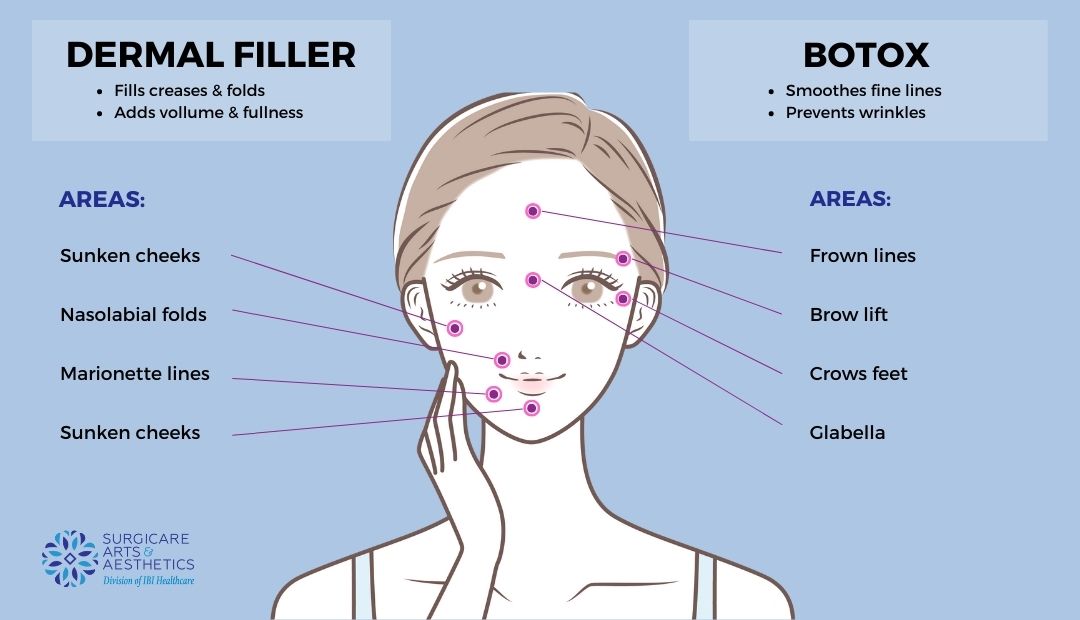People love botox and dermal fillers, they provide instant solutions to so many beauty and health concerns! However, the biggest drawback of using injectables is their temporary results. Botox and dermal fillers vary in lifespan and today we want to cover some of the common questions we get such as “How long does Botox last?”, “How long do face fillers last?” or “How long does Restylane last?”.
We all want to put our best face forward, as the saying goes! Whether in person or remotely, these days it seems we are all “on camera” constantly, even at work, more and more companies are meeting via video calls. It can sometimes seem quite intimidating seeing so much of ourselves on camera, so it is no surprise that the number of cosmetic procedures such as Botox and dermal fillers has doubled and tripled in the last few years.
Statistics from the Aesthetic Plastic Surgery National Database show that Botox procedures were up 54% from 2019 to 2020 and filler procedures increased 75% for the same period.
Botox and fillers are both used to enhance the natural features of the face and help individuals look more youthful. Botox and fillers work wonderfully together but they are different.
What Is Botox?
Botox® is a substance that when injected temporarily paralyzes the mechanisms in the face that cause dynamic facial lines and wrinkles so that the face appears smoother and wrinkle-free. Botox is also used medically to treat overactive sweat glands, headaches, and bladder issues.
When botox is injected into an individual’s face, it will adhere to structures in the nervous system and the muscles will relax and make the face appear smoother. Botox is often used on crow’s feet, forehead, between the eyebrows, laugh lines, and frown lines.
Can Botox Repair or Camouflage a Deep Line?
No, Botox is best used for “dynamic lines” that are wrinkles or lines that appear because of a repetitive motion being done by the muscles in the face. A deep line would best be addressed with a dermal filler.
The filler vs botox chart below demonstrates which cosmetic injectable is appropriate for each area of the face.

How Long Before I See a Difference From Botox?
You will most likely begin to notice a difference a few days after your injections but it normally takes about 7-14 days for the effect to be complete. If you try to frown or squint, you will notice that wrinkles will not form and your whole face will appear more relaxed.
How Long Does Botox Last?
The longevity of botox varies from patient to patient but botox normally lasts about 4 months, sometimes a bit longer. To slow down permanent wrinkle lines caused by repetitive actions like squinting, it is advised to set up botox injections on a consistent schedule. Many have reported that when they kept an ongoing schedule of injections, they did not need them as often and required smaller amounts of botox during these follow-up treatments.
What Is a Dermal Filler?
Most dermal fillers are substances that contain man-made hyaluronic acid that closely resembles the naturally occurring hyaluronic acid found in our skin that keeps it plump and hydrated. Most often lines and wrinkles are caused by volume loss that happens as we age.
Dermal fillers can help restore this lost volume and smooth creases and enhance facial contours. If you are looking for a non-surgical and effective way to replace lost volume to your facial features and help turn back the hands of time, dermal fillers are probably going to become your best friends.
Can a Dermal Filler Procedure be Reversed?
Yes, if for some reason there is a need to remove the dermal filler from an area, the cosmetic surgeon can use an injection to dissolve the HA and reverse the procedure.
How Do I Know Which Dermal Filler is Right for Me?
There are several different hyaluronic acid dermal fillers on the market today to choose from. Some are tailored to work in specific areas of the face and some are known to last a bit longer than others, etc. How do you know which to choose? A consultation with your cosmetic surgeon is going to be the best way to determine which filler will provide the result you desire. Following is a list of some different hyaluronic acid (HA) fillers available, their uses, and expected longevity.
Popular Dermal Fillers Longevity Chart
| Area Of The Face | Product | Typical Longevity |
|---|---|---|
| Lips and liplines | Juvederm® Volbella | 12 months |
| Juvederm® Ulta | 12 months | |
| Restylane®-L | 12 months | |
| Restylane® Kysse | 12 months | |
| Cheeks | Juvederm® Voluma | up to 2 years |
| Radiesse® | 15 months | |
| Chin | Juvederm® Voluma | up to 2 years |
| Radiesse® | up to 15 months | |
| Forehead lines | Juvederm® Vollure | up to 18 months |
| Restylane® Lyft | 12 months | |
| Under eyes | Juvederm® Volbella | 12 months |
| Restylane® | 12 months | |
| Nasolabial folds and marionette lines | Juvederm® Vollure | up to 18 months |
| Restylane® Refyne | 12 months | |
| Restylane® Defyne | 12 months | |
| Restylane® | 12 months | |
| Jawline | Juvederm® Ultra Plus | 12 months |
| Restylane® Lyft | 12 months | |
| Radiesse® | 12 months | |
| Temples | Juvederm® Voluma | 24 months |
| Restylane® Lyft | 12 months | |
| Restylane® | 12 months | |
| Midface | Juvederm® Voluma | 24 months |
| Nose | Restylane® | 12 months |
How Can I Make My Dermal Filler Last Longer?
Experts agree that getting maintenance touch-ups during the midpoint of your filler’s expected longevity is the key to it lasting much longer. For instance, if you have had Juvederm® Volbella under your eyes and it typically lasts a year, having a small touch-up at the six-month point keeps the volume constant and fresh.
The injections also jump-start your skin’s natural collagen production so doing the maintenance keeps your collagen production going contributing to your skin’s volume and appearance. You should also avoid UV ray exposure and stay hydrated to help maintain the results of your dermal fillers.
Are There Any Fillers That Last Longer Than 2 Years?
There are fillers that are composed of a synthetic material called Polymethyl-methacrylate microspheres (PMMA fillers) that can last up to five years. Because these fillers are not close to anything natural in the body, they have a higher risk of complications and PMMA fillers cannot be metabolized by the body like the HA fillers and must be removed surgically if something goes awry.
Some cosmetic surgeons do not use PMMA fillers but they use a family of products that they are well educated on and have had great success in using. Choose a highly knowledgeable medical professional and trust that knowledge to help you decide on the product that is right for you.
In just a few minutes, the hands of time can be turned back, wrinkles reduced and replaced with smoother skin and a healthy youthful glow. If you desire to minimize the signs of aging and restore diminished volume to your face please feel free to set up a personal consultation with us today.
Dr. Angelina Postoev, MD, FACS, a triple board-certified cosmetic surgeon, and Christopher Ibikunle offer injections with Botox® and dermal fillers to patients in Lawrenceville, Suwanee, Johns Creek, Buckhead, and the surrounding areas of Atlanta, Georgia.






